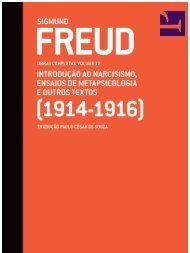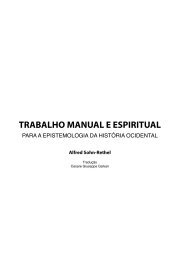Perversion the Social Relation
Perversion the Social Relation
Perversion the Social Relation
- No tags were found...
You also want an ePaper? Increase the reach of your titles
YUMPU automatically turns print PDFs into web optimized ePapers that Google loves.
198 E. L. McCallumindividualist paradigm of <strong>the</strong> drive and its links to repetition and <strong>the</strong>symbolic.Lacan describes cause as having "something anti-conceptual, somethingindefinite," 15 a point that Joan Copjec picks up in relation to <strong>the</strong>death drive. Although her reading hinges more on Lacan's than, as myfocus has been, exclusively on Freud's views of <strong>the</strong> drive, her emphasison <strong>the</strong> fragment, fraction, part—signaled in her very title, "CuttingUp"—renders her considerations of <strong>the</strong> drive and <strong>the</strong> role of failure relevan<strong>the</strong>re. For Copjec's reading of cause unites Lacan's with mid-centuryphilosophical views of causality that link it to failure ra<strong>the</strong>r than succession,conjunction, or sequence. On this reading, cause comes to be seenas perverse—a deviation from normal circumstances. If a firebreaks out,as it did in <strong>the</strong> Chernobyl reactor, its immediate cause is not <strong>the</strong> oxygenthat is none<strong>the</strong>less necessary for <strong>the</strong> fire to exist. Cause also linksto narrative through this juncture of deviance and <strong>the</strong> death drive, foras Brooks notes, "Deviance is <strong>the</strong> very condition for life to be narratable";16 any adherence to normal circumstances, any lack of failure, isnot narrative.Copjec claims that Lacan's reading goes beyond H. L. A. Hart's andA. Honoré's, in Causality and <strong>the</strong> Law, to place cause at <strong>the</strong> level of <strong>the</strong>materiality of language, not at <strong>the</strong> level of a subject's conscious intentionality.Indeed, Copjec concludes that "<strong>the</strong> cause which must necessarilyexist is never present in <strong>the</strong> field of consciousness that it effects," 17which is precisely why her account goes by way of <strong>the</strong> drive, as <strong>the</strong> forcesthat organize outside <strong>the</strong> conscious field. For her, <strong>the</strong> drive—and specifically<strong>the</strong> death drive—governs <strong>the</strong> relation between <strong>the</strong> psychic and<strong>the</strong> social. The link is linguistic: in Lacan's view <strong>the</strong> death drive prevailsover <strong>the</strong> signifying chain, or as he calls it, automaton, because semioticmeaning happens regardless of human intention. Copjec points outthat this is <strong>the</strong> same term Aristotle uses to describe coincidence, whatoccurs "as a result of a collision of separate events." 18 Since automatonconcerns how language produces effects independently of intention, automatonpresents a paradigm of nonhuman agency, and this chain is bothsocial and incomplete. The death drive, which Copjec conflates with<strong>the</strong> reality principle, intervenes to delay: The reality principle "maintainsdesire beyond <strong>the</strong> threats of extinction presented by satisfaction.The death drive does not negate <strong>the</strong> pleasure principle, it extends it." 19








